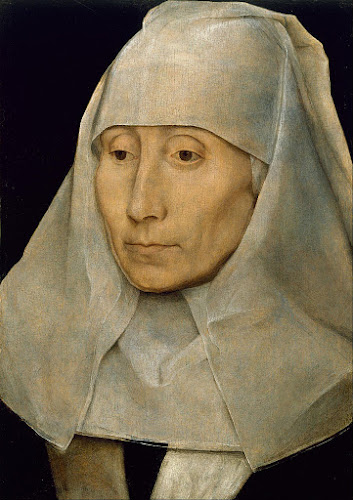 |
| Petrus Christus Portrait of a Woman (detail) ca. 1470 oil on panel Gemäldegalerie, Berlin |
 |
| Petrus Christus Portrait of a Woman ca. 1470 oil on panel Gemäldegalerie, Berlin |
 |
| Albrecht Dürer Portrait Diptych of the Artist's Parents ca. 1490 oil on panel Galleria degli Uffizi, Florence |
 |
| Anonymous Flemish Artist Portrait of a Prince in Armour ca. 1450-80 oil on panel National Trust, Waddesdon Manor, Buckinghamshire |
 |
| Anonymous German Artist Portrait of a Married Couple ca. 1470 oil on panel Cleveland Museum of Art, Ohio |
 |
| Anonymous German Artist Portrait of a Woman ca. 1470 oil on panel National Gallery, London |
 |
| Robert Campin Portrait of a Man ca. 1435 tempera and oil on panel National Gallery, London |
 |
| Robert Campin Portrait of a Woman ca. 1435 tempera and oil on panel National Gallery, London |
"The new class of people who elbowed their way in between the common folk and the aristocracy and clergy, namely the urban bourgeoisie, gradually acquired importance and soon became a driving force in society, productive and progressive on both an economic and artistic level. Though the now-rich bourgeoisie adopted aristocratic airs, their mentality and vision had scarcely changed. Thus, it was not without reason that naturalism in art reached such heights at this time: one may simply call it the self-projection of this generally sober-minded middle class. The emergence of painting as a movable work of art was no less accidental: paintings could be acquired individually, bought and sold, they could be placed and displayed anywhere, they were cultural commodities with a private character, even though most still had a definite religious function. It is indeed striking how few paintings were destined for the courts, which tended to favour tapestries, silverware and illuminated books. The demand for high-quality paintings on panel in the municipalities of the Southern Netherlands was responsible for the social continuation of painting as a profession, so that the most talented artists came into their own on a regional level rather than at court. The relationship between royal patronage and a high standard of painting was no longer self-evident."
– Dirk de Vos, The Flemish Primitives (Princeton University Press, 2002)
 |
| Hans Memling Portrait of Benedetto Portinari (from the Portinari Triptych) 1487 oil on panel Galleria degli Uffizi, Florence |
 |
| Hans Memling Portrait of a Man ca. 1490 oil on panel Galleria degli Uffizi, Florence |
 |
| Hans Memling Portrait of an Old Woman ca. 1468-70 oil on panel Museum of Fine Arts, Houston |
 |
| Rogier van der Weyden Portrait of Antoine de Bourgogne (known as Le Grand Bâtard) ca. 1440-50 oil on panel Musées Royaux des Beaux-Arts, Brussels |
 |
| Rogier van der Weyden Portrait of a Woman ca. 1445 oil on panel Gemäldegalerie, Berlin |
 |
| Rogier van der Weyden Portrait of a Woman (detail) ca. 1445 oil on panel Gemäldegalerie, Berlin |
 |
| Rogier van der Weyden Portrait of a Woman (detail) ca. 1445 oil on panel Gemäldegalerie, Berlin |